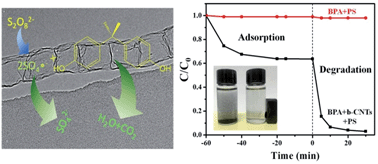Bamboo-like carbon nanotubes derived from colloidal polymer nanoplates for efficient removal of bisphenol A†
Abstract
Bamboo-like carbon nanotubes (b-CNTs) were synthesized via a low-cost one-pot approach by using FeCl3 and self-assembled colloidal polymer nanoplates as precursors. The resulting b-CNTs were applied as both the adsorbent and the catalyst for the removal of bisphenol A (BPA) from aqueous solutions. The maximum adsorption capacity of BPA on the b-CNTs calculated by using the Langmuir model is 328.6 mg g−1 at 303 K. Thermodynamics studies revealed that the adsorption was spontaneous and exothermic. With the synergistic effect of adsorption and catalysis by the b-CNTs, BPA (70 mg L−1) was almost completely removed (over 97%) at pH 7.0 within 80 min after the adsorption–oxidative degradation process. The b-CNTs also displayed an excellent reusability for the catalytic oxidation of BPA (initial concentration of 70 mg L−1) with the degradation ratio remaining at 84% after 5 cycles. Moreover, the b-CNT catalysts can be easily recycled by using an external magnet and regenerated by simply washing. This study not only presents a cost-effective method of using magnetic nanocarbons for the cleanup of pollutants, but also demonstrates the potential application of the b-CNTs as both an adsorbent and a catalyst.


 Please wait while we load your content...
Please wait while we load your content...